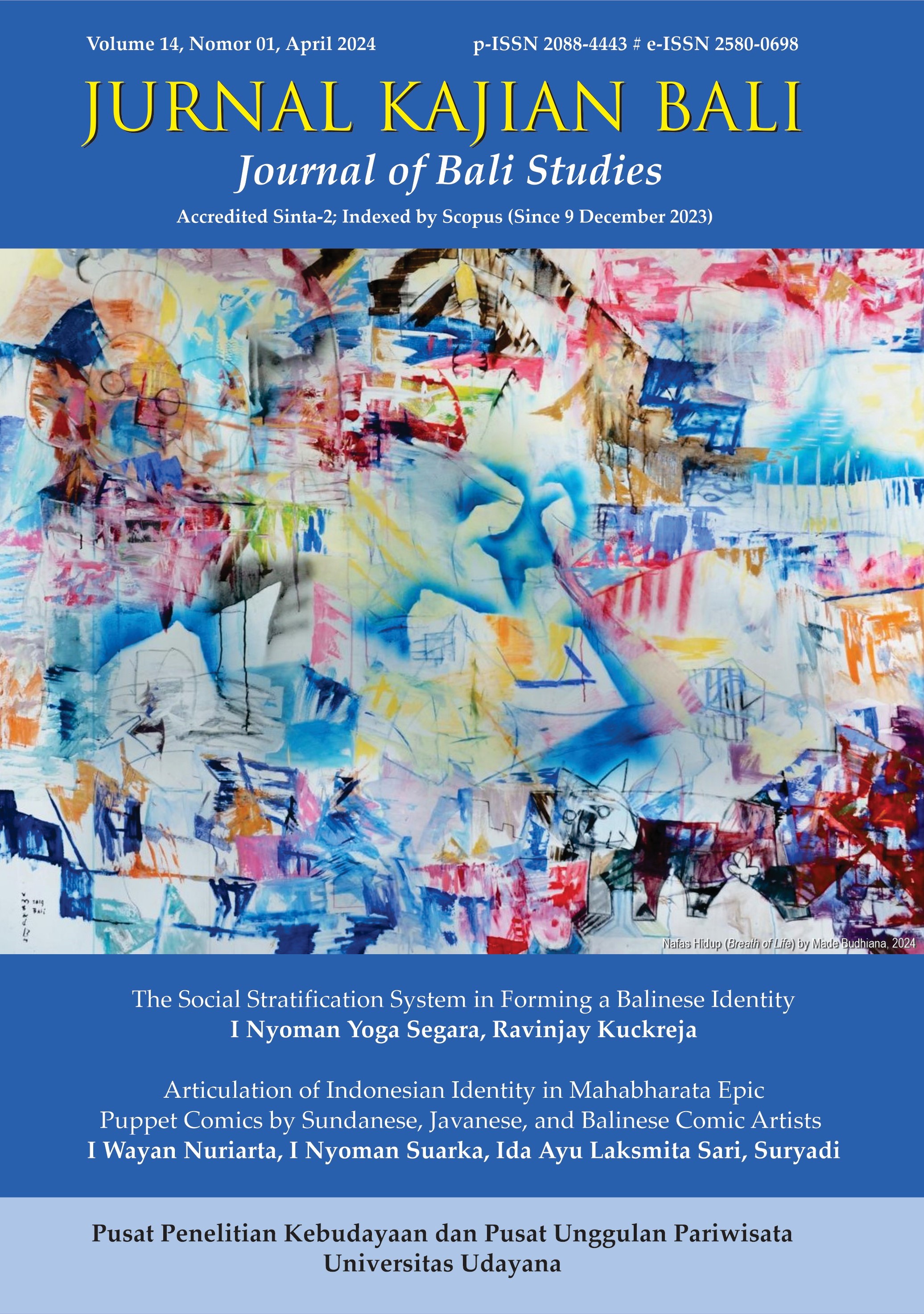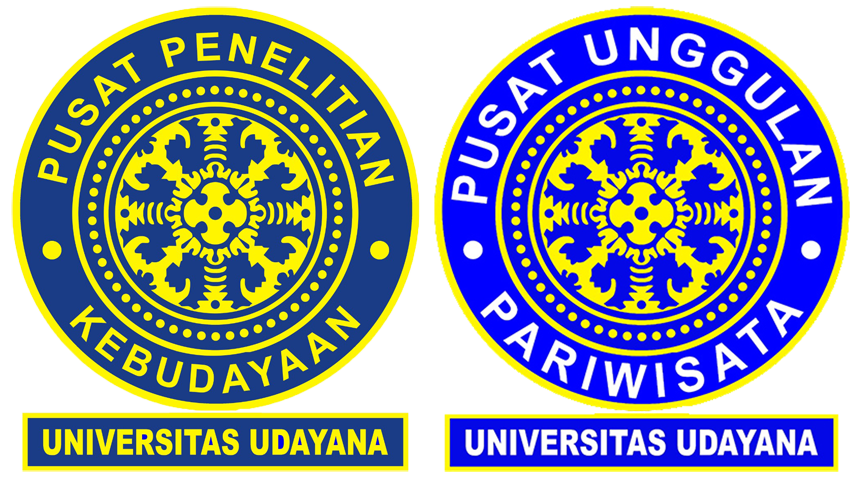Priority of Criteria for Agritourism Development in Bali
Abstract
Agritourism in Bali has not been developed optimally yet. As a basis for development of agritourism, the criteria should be determined and priorities among criteria need to be set. The objectives of this research were: (i) to identify criteria for agritourism development; and (ii) to analyze the priorities for selected criteria according to the agritourism stakeholders in Bali. This research implemented Analytic Hierarchy Process (AHP) method which involved 20 key informants representing agritourism stakeholders. The finding was the priority criteria for agritourism development in Bali, namely: (1) Attractions, followed by (2) Local Community Involvement, (3) Ancillary Services, (4) Marketing, (5) Amenities, and (6) Accessibility. This kind of research has not been undertaken previously in Bali. It contributes to academic and practical implications, particularly in agritourism development planning in Bali, in which development of agritourism should be focused on the diversification of agritourism attractions supported by professional management and community participation.
Downloads
References
Andayani, N.L.H., Wiranatha, A.S., Suryawadani, I G.A.O., and Mananda, I G.P.B.S. (2024). Developing eco-agritourism based on resource-based theory in Klungkung Regency, Bali. International Journal of Tourism and Hotel Management, 6(1): 77-87. DOI: https://doi.org/10.22271/27069583.2024.v6.i1b.89
Attri, R., Dev, N., and Sharma, V. (2013). Interpretive Structural Modelling (ISM) approach: An Research Journal of Management Sciences Overview. Research Journal of Management Sciences, 2(2): 3-8, February. International Science Congress Association.
Baipai, R., Gandiwa, C.O. , and Mutanga, E. (2022). Critical success factors for sustainable agritourism development in Zimbabwe: A multi-stakeholder perspective. African Journal of Hospitality Tourism and Leisure, 11:617-632. DOI: https://doi.org/10.1080/23311886.2023.2201025
Bhatta, K., and Ohe, Y. (2020). A review of quantitative studies in agritourism: The implications for developing countries. Tourism and Hospitality, 1:23-40.
Binns, T., and Nel, E. (2002). Tourism as a local development strategy in South Africa. The Geographical Journal, 168(3): 235-247.
Budiasa, I.W., and Ambarawati, I G.A.A. (2014). Community Based Agro-Tourism as an Innovative Integrated Farming System Development Model Towards Sustainable Agriculture and Tourism in Bali. Journal of ISSAAS, 20(1): 29-40.
Checkland, P. (1999). Systems Thinking, Systems Practice. John Wiley & Sons, Ltd. West Sussex, England. 330p.
Cheteni, P., and Umejesi, I. (2022). Evaluating the sustainability of agritourism in the wild coast region of South Africa. Cogent Economics & Finance,11(1):1-12. DOI: https://doi.org/10.1080/23322039.2022.2163542
Contini, C., Scarpellini, P. and Polidori, R. (2009). Agritourism and rural development: the Low-Valdelsa case, Italy. Tourism Review, 64(4): 27-36. DOI: https://doi.org/10.1108/16605370911004557
Cooper, C., Fletcher, J., and Fyall, A. (2008). Tourism Principles and Practice. Fourth Edition. Pearson, Harlow. 704p.
Cooper, C. (2016). Essentials of Tourism. Second Edition. Pearson Education Limited. Oxford Book University. 360p.
Din, G.Y., and Yunusova, A.B. (2016). Using AHP for evaluation of criteria for agro-industrial projects. International Journal of Horticulture and Agriculture, 1(1):1-6.
Dinas Pariwisata Provinsi Bali. (2020). http://www.disparda.baliprov.go.id/
Eriyatno. (2012). Teori Sistem. Meningkatkan Kualitas dan Efektifitas Manajemen. Jilid 4. Penerbit Guna Widya, Surabaya. 210p.
Eriyatno and Larasati, L. (2013). Ilmu Sistem. Meningkatkan Integrasi dan Koordinasi Managemen. Jilid 2. Center for System. Penerbit Guna Wijaya, Surabaya. 292p.
Eshliki, S. A., and Kaboudi, M. (2012). Community perception of tourism impacts and their participation in tourism planning: a case study of Ramsar, Iran. Procedia-Social and Behavioral Sciences, 36: 333-341.
Flanigan, S., Blackstock, K. and Hunter, C. (2014). Agritourism from the perspective of providers and visitors: a typology-based study. Tourism Management, 40: 394-405. DOI: https://doi.org/10.1016/j.tourman.2013.07.004
Fleischer, A., and Tsur, Y. (2000). Measuring the recreational value of agricultural landscape. European Review of Agricultural Economics, 27(3): 385–398.
Fun, F.S., Chiun, L., Songan, M, and Nair, V. (2014). The impact of local communities' involvement and relationship quality on sustainable rural tourism in a rural area, Sarawak. The moderating impact of self- efficacy. Procedia-Social and Behavioral Sciences, 14(2): 60-65.
Fyall, A., Legoherel, P., Frochot, I., and Wang, Y. (2019). Marketing for Tourism and Hospitality: Collaboration, Technology and Experiences. Routledge. London. 110p.
Gladstone, J., and Morris, A. (2000). Farm accommodation and agricultural heritage in Orkney. In Brown, F. (Ed.). Tourism in peripheral areas: Case studies (pp. 91–100). Clevedon: Multilingual Matters Limited.
Henry, B. C. (2013). New Paradigm of Systems Thinking. International Journal of Economics, Finance and Management, 2(5): 351-355.
Karampela, S., Kavroudakis, D., and Kizos, T. (2019). Agritourism networks: empirical evidence from two case studies in Greece. Current Issues in Tourism, 22(12): 1460-1479. DOI: https://doi.org/10.1080/13683500.2017.1379475
Kima, S., Leeb, S.K., Leea, D., Jeongc, J., and Moon, J. (2019). The effect of agritourism experience on consumers’ future food purchase patterns. Tourism Management, 70: 144–152. DOI: https://doi.org/10.1016/j.tourman.2018.08.003
Koc, E. (2008). The New Agritourism: Hosting Community & Tourists on Your Farm. Annals of Tourism Research, 35(4): pp. 1085–1086.
Kotler, P., Armstrong, G., and Opresnik, M.O. (2017). Principles of marketing (17e). Harlow, England: Pearson. 205p.
Kubickova, M. and Campbell, J. M. (2018). The role of government in agro-tourism development: a top-down bottom-up approach. Current Issues in Tourism, 11(1): 1-18. DOI: https://doi.org/10.1080/13683500
Leea, K. A., Nhung, T., Nguyen, P.T., Hang, T., Tran, N., Nguyen, T. L., and Thuong, V. Q. K. (2023). Determinants of agritourism development in green tea farms of the northern mountains of Vietnam: A hybrid approach based on the combination of Diffusion of Innovation (DOI) theory and PLS-SEM. Oct (23): 1-14.
McGehee, N. G. (2007). An Agritourism Systems Model. Journal of A Weberian Perspective, 15(2): 111-122.
Meadows, D.H. (2009). Thinking in Systems. Diana Wright, D. (Editor), Sustainability Institute. Eartscan Publishing for sustainable in future. Dunstan House, London. 232p.
Middleton, V.T., Fyall, A., and Morgan, M.. (2020). Marketing in travel and tourism. Buttcnvtrrth-Hcitrcntatrn is an imprint. Elsevier. 216p.
Mill, R. C. and Morrison, A.M. (2009). The Tourism System. Kendall Hunt Publishing Company. The United States of America. 436p.
Miura, K., and Sarjana, I. M. 2016. The world heritage nomination of Balinese cultural landscapes local struggles and expectations, in n V. T. King (Ed.), UNESCO in Southeast Asia: World heritage sites in comparative perspective (274-290). Copenhagen: NIAS Press worldwide.
Nastiti, A.P., Hakim, L., and Soemarno. (2019). Community Participation in Agrotourism Development at Karangsari, Blitar, East Java. Journal of Environmental Engineering & Sustainable Technology, 6(2): 36-43.
Patricia, T.C., Suryawardani, I G.A.O., Suamba, I.K., and Wiranatha, A.S. (2020). Farmers’ capacity for Jatiluwih Agrotourism management and its effects on tourists’ satisfaction and intention to revisit. E-journal of Tourism, 7(1): 1-15. DOI: https://doi.org/10.24922/eot.v7i1.58216
Phillip, S., Hunter, C. and Blackstock, K. (2010). A typology for defining agritourism. Tourism Management, 31(6): 754-758. DOI: https://doi.org/10.1016/j.tourman.2009.08.001
Pitana, I. G. and Putra, I G. S. A. (2013). Pariwisata sebagai wahana pelestari subak, dwn budaya subak sebagai modal dasar dalam pariwisata. Jurnal Kajian Bali, 3(2): 159-180.
Ramappa, K., Kumar, B., Sivastava, R.C., and Andukuri, R.S. (2022). Opportunities & Challenges of Agritourism. Indian Research Journal of Extension Education, 22(3) July-September 2022: 78-84.
Reza, S., Tabrizi, Foong, Y.P., and Ebrahimi, N. (2010). Determine the Relationships among Knowledge Management Criteria Inside Malaysian Organizations. World Academy of Science, Engineering and Technology.
Rogerson, C.M. and Rogerson, J.M. (2014). Agritourism and local economic development in South Africa. Bulletin of Geography. Socioeconomic Series, 26(26): 93-106.
Saaty, T.L. (2008). Decision making with the analytic hierarchy process. Int. J. Services Sciences, 1(1): 83-98.
Sarjana, I. M., Pitana, I. G., Putra, I N.D., and Wiranatha, A.S. (2021). Establishing the positioning of agritourism product towards the collaborative marketing of Community Based Agritourism Subak Jatiluwih Bali. Journal of Tourism and Hospitality Management, 9(4): 221-237.
Satriawan, I K., Pujaastawa, I.B.G & Sarjana, I M. (2012). Strategi Pengembangan Model Agrowisata Berkelanjutan Berbasis Pemberdayaan Masyarakat di Provinsi Bali. Prosiding Seminar Nasional Nasional Program Studi Teknologi Pertanian bekerjasama dengan Asosiasi Profesi Teknologi Agroindustri (APTA). Halaman 365-373.
Seiler, J. H., and Kowalsky, M. (2011). Systems Thinking Evidence from Colleges of Business and their Universities. American Journal of Business Education, 4(3): 55-61.
Senge, P. (1990). The Fifth Discipline: The Art and Practice of the Learning Organization. Systems thinking in a business environment, and also the broader philosophical tools that arise from and complement systems thinking, such as mental-model flexibility and visioning. New York: Doubleday. 245p.
Sgroi, F., Donia, E. and Mineo, A.M. (2018). Agritourism and local development: A methodology for assessing the role of public contributions in the creation of competitive advantage. Land Use Policy. 77: 676-682.
Sherwood, D. (2002). Seeing the Forest for the Trees: A Manager’s Guide to Applying Systems Thinking. London: Nicholas Brealey Publishing. 322p.
Sterman, J.D. (2000). Business Dynamics: Systems Thinking and Modeling for a Complex World. (Boston: Irwin McGraw Hill, 2000). 212p.
Sumantra, I. K. and Yuesti, A. (2018). Evaluation of Salak Sibetan Agrotourism to support community-based tourism using logic model. International Journal of Contemporary Research and Review, 9(01): 23-31.
Suryani, E., Azis, S. and Iskandar, T. (2018). Priority Scale Analysis using Analytical Hierarchy Process (AHP) to Determine Traditional Market Development in Tulung Agung District. International Journal of Scientific Engineering and Science, 2(9): 31-37.
Suryawardani, I G.A.O., Bendesa, I K.G., Antara, M. and Wiranatha, A.S. (2014). Tourism Leakage of Accommodation in Bali. ASEAN Journal on Hospitality and Tourism, 13(1): 3-17. DOI: https://doi.org/10.5614/ajht.2014.13.1.01
Suryawardani, I G. A. O., and Wiranatha, A. S. (2016). Strategy prioritization for sustainable tourism in Bali, Indonesia: Focusing on local agricultural products analytical hierarchy process (AHP) approach. The International Society for Southeast Asian Agricultural Sciences (ISSAAS), 22(1): 96-110.
Suryawardani, I G.A.O., Wiranatha, I K. Satriawan, I.B.G. Pujaastaawa, E.N. Kencana, and I W. Tika. (2021). The Role of Branding in Increasing Revisit to Agritourism. SOCA, 15 (2): 235-244. DOI: https://doi.org/10.24843/SOCA.2021.v15.i02.p01
Swarbrooke, J. and Horner, S. (2009). Consumer Behaviour in Tourism. Second Edition. British Library Cataloguing in Publishing Data. 198p.
Sznajder, M., Przezbórska, L. and Scrimgeour, F. (2009). Agritourism. CAB International. 301p.
Tew, C., and Barbieri, C. (2012). The perceived benefits of agritourism: The provider's perspective. Tourism Management, 33(1): 215-224. DOI: https://doi.org/10.1016/j.tourman.2011.02.005
UNWTO. (2009). Tourism and Community Development - Asian Practices. [cited 2024 February 14: 9 pm]. DOI: https://doi.org/10.18111/9789284411948
UNWTO. (2012). Sustainable Development. [cited 2024 February 14: 10 pm]. Available from URL: http://sdt.unwto.org/en/ content/about-us-5.
Wiranatha, A.S., Suryawardani, I G.A.O., Bendesa, I K.G., and Antara, M. (2016). Model of Foreign Tourists’ Loyalty on Marine Tourism to Visit Bali”. International Journal of Multidisciplinary Educational Research (IJMER), Volume 5. Issue 3(1):1-42.
Wiranatha, A.S., Antara, M., and Suryawardani, I G.A.O. (2017). Impact of Tourism Leakage on the Growth of Economic Sectors, Employment and Income Distribution in Bali, Indonesia. International Journal of Economic Research (IJER), 14(8): 11-27.
Wiranatha, A.S., Dalem, A.A.G.R., Ariana, N., Sarjana, I M., and Arismayanti, N.K. (2019). Kajian Subak Sembung. Denpasar. Dinas Pariwisata Kota Denpasar bekerjasama dengan Pusat Unggulan Pariwisata Universitas Udayana. 67p.

This work is licensed under a Creative Commons Attribution 4.0 International License.



















